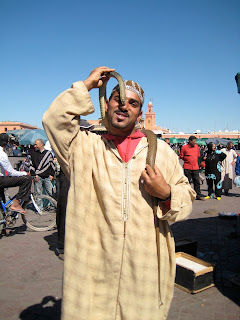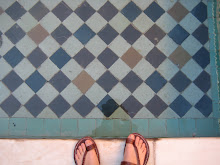I'm back everyone from a land of much needed sunshine, bustling markets, and colorful mosques. Morocco was a great trip for my friends and myself as we tackled three of its most popular cities- Casablanca, Fes, and Marrakech. This trip is on par with the one I took to Mexico a few years back as one of the most culturally eye-opening experiences of my life (as I'm sure you will see why once you get to the pictures). It is always particularly interesting to visit a place where you are the minority; where you are the one that is looked at as different. It is hard to understand that feeling unless you are knee deep in it such as we were being a group of English-speaking, "western" tourists in an Arab Muslim country. However, we were treated hospitably and often people went out of their way to help us or even show us a more of Morocco.
Also, I greatly appreciated everyone's concern for me traveling through North Africa during these turbulent times. My friends and I were scouring the news, US and UK government updates, and other Internet sources constantly beforehand to ensure that conditions were safe. During our stay we fortunately didn't see any signs of protests or public disturbances. All went smoothly for the most part (a few minor train confusions being about the worst of it).
So on to the pictures!
 |
| Here was the view from our hotel out over the port of Casablanca. Casablanca is the largest city with the busiest industrial center and busiest port in all of North Africa, which is also known as the Maghreb region. |
 |
| Here is a good example of the type of flora we were coming across throughout Morocco. |
 |
|
Next you see the Hassan II mosque. This is the tallest mosque in the world and was finished in 1993 for the former king of Morocco. It is also the third largest mosque in the world.
|
|
 |
| The mosque is on the sea front of the Atlantic. Inside the mosque the floor is made of glass so worshipers can see the ocean below. It was a little pricey to go in, so unfortunately we were unable to see this crazy sounding floor. |
 |
| As you can see, here I stand in front of one of the many fountains of the colorful mosque. |
 |
| Just like out of the movie Casablanca, we found Rick's Cafe. |
 |
| Inside the commons area at our hotel where we were served a lovely breakfast with incredible tea and coffee. |
 |
| This was the view from the train on the ride to the city of Fes, the second largest city in Morocco. |
 |
| In most Arab cities there is an old town known as the Medina and a more modern region often called the Nouvelle Ville (French for New City). A Medina houses an Arab city's markets and is always surrounded by a protective, outer wall as you can see here in Fes. |
 |
| We stayed within the Medina in Fes, which meant we were right by the extensive markets where vendors were on the prowl to haggle with you for their goods. In the next few pictures you can see the typical local products that we encountered daily. (Not pictured, but worth noting were the local butchers who hung up slabs of meat for sale ranging from cow insides to goat heads.) |
 |
| In Fes we saw many ornate fountains where locals would come to fill up their water jugs. |
 |
| Restaurants with terraces overlooking the Medina were available mostly for tourists. You were even expected to haggle for the price of your meal often. |
 |
| Here I am with some random street musicians/dancers we came across. |
 |
| The inside of the hostel in the Medina. |
 |
| The hostel employee/host shows us his skills with the local instruments (something kind of like a guitar, but with only three strings and made out of wood, goat hide, and goat intestines.) |
 |
| Having a herd of donkeys run by you on your walk home seemed normal by the time we left. |
 |
| We've made it now to Marrakech, the most popular city for tourists. Here is the local mosque in the Kasbah, which is a part of the Medina. Where we stayed was close by and we passed this area every time we left the house we were renting out. |
|
 |
| Now the fun begins in the huge main plaza in Marrakech called the Djemma el Fna. The square is packed with acrobats, story-tellers, water sellers, dancers and musicians. |
 |
| Just like in the movies we witnessed local men playing oboes and other instruments to supposedly hypnotize cobra snakes. |
 |
| The fresh orange juice stands were a favorite of ours. |
 |
| This square was surrounded by terraced restaurants, so diners could overlook the craziness below. |
 |
| Marrakech has the largest markets or souks in all of Morocco. It felt like this almost flea market type set up stretched on for miles where we again were offered everything from rugs to leather bags to basic souvenirs. |
 |
| The entrance to one of the many local palaces inhabited by the wealthy in former times. |
 |
| Inside the palace. |
 |
| Yummy! This delicious homemade pancake/crepe type goodness called Mssemen was our daily breakfast. |
 |
| Entrace to the gardens created by the French artist, Yves Saint-Laurent. |
 |
| Me by a very tall cactus in the gardens. |
 |
| Bamboo! |
 |
| After the gardens we strolled through the Nouvelle Ville, which seemed like night and day compared to the old Medina. |
 |
| Heading up to the Menara gardens where there's a largest man-made lake as well as olive tree groves. |
 |
| A look back at the Koutoubia mosque from the entrance to the gardens. |
 |
| Camels! Always wanted to see a camel! |
 |
| My friend Anne standing by the lake in the gardens. |
 |
| At night the Djemma el Fna was filled with literally hundreds of open air food vendors each yelling at you to choose their services over the others. |
 |
| The yummy couscous and vegetables. |
 |
| Entrance to the Medrasa Ben Youssef. This was the former Quaranic school were religious scholars lived together studying and practicing Islam. Now it's a museum maintained by the state with beautiful mosaics and pools. |
 |
| See my reflection? |
 |
| Example of the typical room held by a student in the school a couple hundred years ago. |
 |
| Here you can see our view from one of the terraced restaurants and really get a better grasp of how large and chaotic the Djemma el Fna was. Also, notice the looming Koutoubia mosque in the background. |
 |
| Also, from atop our restaurant we could clearly see the Atlas mountains in the distance. |
 |
| Inside the restaurant. |
 |
| Djemma el Fna at night. |
 |
| Tea is essential to life in Morocco. It is served everywhere in pots and cups like this and absolutely delicious. |
 |
| Typical dress of the men in Morocco. |
 |
| A better look at how large and close the Atlas mountains were. |
|
|
Well, that was about it for Morocco. It was quite the trip and I'm very glad I was able to share some of it with you. Until next time...












































































































